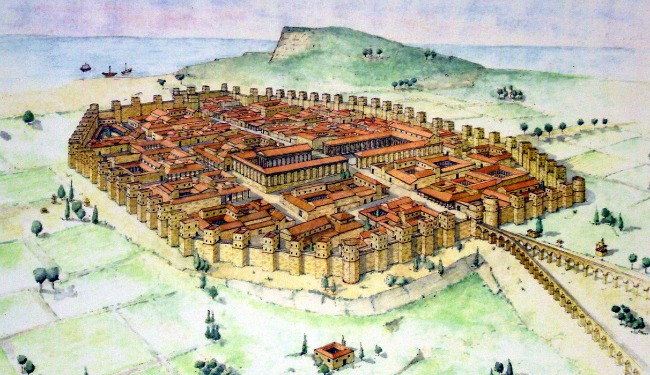
A short walk round Barcelona's Ciutat Vella, literally Old City, makes it obvious that the city was once the capital of a great empire. Today, in fact, Barcelona is probably the most important city in Europe that is not the capital of a state. In many respects this is a problem for landlocked and less obviously attractive Madrid, which although a wonderful city, doesn't have quite the same charms as Barcelona, the Gran Encisera or Great Enchantress.
Founded as a Roman castrum or military encampment in around 14 BC on the site of an Iberian settlement, Barcino was one of the many natural ports along the stretch of coast between Emporion, where the Roman originally landed, and Tarraco or Tarragona, which they made their capital. It was set on a small hill, Mons Taber, a short way back from the sea and had two main streets Decamanus Maximus and Cardus Maximus, which still run through the Gothic Quarter as Carrer del Bisbe and Carrer de la Llibreteria respectively.
By the second century AD, Barcino was a fortified oppidum with a population of around 5,000. Long sections of the original Roman walls can still be seen today and three surviving column of the Temple of Augustus stand at the peak of Mont Taber on Carrer Paradis just behind the Cathedral. As I mentioned in an earlier chapter, the Palau de la Generalitat stands roughly on the site of the Roman forum so government has been exercised from the same location in Barcelona for more than 2,000 years.
Recent excavations suggest that, particularly throughout the later stages of the Roman Empire, Barcino was significantly more important than originally thought. When Roman control began to weaken in the early 5th century and Hispania was invaded by Germanic tribes, it is not surprising then that the Visigoths made Barchinona one of their important centres.
Ataülf established his court in Barchinona before being murdered by his troops there in 415 AD and his successor, Wallia, moved the capital of the Visigoth empire of Aquitania and Gallia Narbonensis to Toulouse leaving Barchinona as an important military post because of its fortified walls and trading port. From about 500 AD onward, Barchinona alternated as capital of the Visigoth empire with Toulouse until Toledo was made capital of Visigoth Hispania under Leovigildus in 573 AD.
It seems clear that, although part of Spain now, Barcelona's historical position has always been as part of a territory straddling modern Spain and France that looks out towards the Mediterranean. This is the territory where Catalonia exercises its cultural and linguistic influence and even today she is capital of a European Union megaregion, which stretches along the Mediterranean coast from Marseille to Valencia. Catalonia is not Spain because it is much more than that.
****************************************
This excerpt is taken from the Chapter 7 of my forthcoming book 'Catalonia Is Not Spain: A Historical Perspective'
You can find out more on My Blog
Or help me get the book published by contributing to my Crowdfunding Project on Verkami